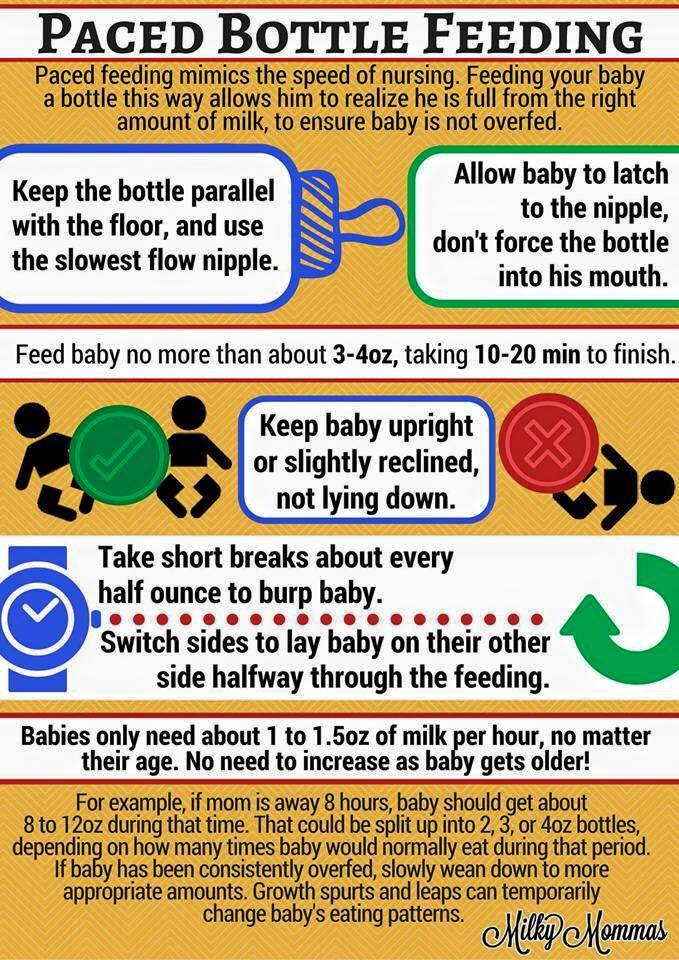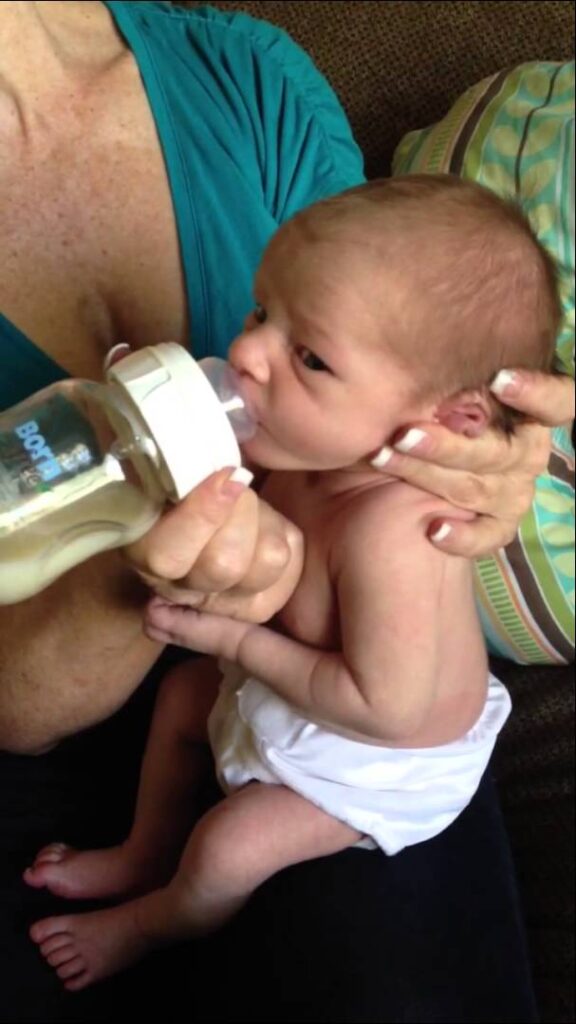Getting ready to introduce a bottle to your breastfed baby can feel overwhelming. How much to give, what kind of bottle, how to give the bottle. Honestly, these questions are one of the main reasons why I decided to breastfeed in the first place. It all just seemed too difficult to figure out. It’s recommended to practice paced bottle feeding with babies when offering a bottle. What is paced bottle feeding, anyway? What are the benefits of paced bottle feeding?
Overfeeding
Overfeeding when breast / chest feeding is different from overfeeding by bottle. It is not as common for a baby to overfeed when breast/ chest feeding. When babies are breast / chest feeding, they will learn pretty quickly how to control their feeds. They figure out how to take exactly what they need. They are in control.
Bottle Feeding
Contrary to popular belief, babies actually have a harder time bottle feeding than they do breastfeeding. It is a common misconception that your babe will find it much easier to bottle feed.

Science Behind Breast And Bottle
While breastfeeding, breathing is combined with sucking and swallowing, usually happening in bursts. This action helps infants manipulate breathing patterns to control and accommodate breathing. Sucking during bottle feeding can interrupt breathing more frequently, and for a longer duration of time. Breastfeeding also promotes the infant’s ability to breathe through the nose, which aids in heating and filtering air before reaching the lungs. Moreover, air coming in through the nose puts additional pressure on the palate, which encourages and accompanies general growth of facial muscles and body.
The masseter muscle, which is the muscle that supports the up and down movement of the jaw, is important to facilitating jaw growth and positioning. Bottle feeding actually reduces the activity of the masseter muscle, reduces jaw movement, and may cause the tongue to retract. The science behind all of this is so interesting, and you can read more about it in this blog.
Overfeeding By Bottle
It is very easy to overfeed a baby when bottle feeding. This is because your baby’s suck reflex is involuntary for the first 3 months of life. The suck reflex is just that…a reflex. They can’t control it. Therefore, when you offer a bottle, it is likely your baby will suck it down in record time, regardless the amount. You can learn more about infant reflexes here.
Learning Paced Bottle Feeding
Recognizing that your baby is overfeeding when you bottle feed is an important part of the feeding process. You don’t want your baby to overfeed, just as it’s not good for adults to overfeed. If your baby is overfeeding by bottle, you may find they are gassier, fussier, spitting up more. Paced bottle feeding will help control all of this, and make you feel more confident that your baby is only taking what they need.
Paced bottle feeding isn’t hard to learn, and once you are comfortable with it, you won’t ever go back to traditional bottle feeding. There are a few things to remember when you are learning about paced bottle feeding.

Feed On Demand
Continue to feed on demand. Babies that are predominantly bottle-fed tend to be on more of a scheduled routine. We encourage following your baby’s cues when breastfeeding, and bottle feeding should be the same. If you are offering bottles when your baby isn’t hungry, this will lead to overfeeding. Remember the suck reflex in your baby is involuntary for the first few months of life. If you put a bottle in their mouth their reflex is to suck. A suck will facilitate a swallow, which leads to another suck, and so on. Before you know it, the bottle is gone and your baby may not have been hungry to begin with.
Keep Baby Sitting Up
Hold your baby in more of an upright position. Do not cradle them in your arms. This is because with bottle feeding, it is easier for fluid to drain into their ears if they are feeding by the bottle in a reclined position (this is not the same for breastfeeding). This can lead to increased ear infections.
With your baby in an upright position, offer the bottle by gently stroking the baby’s lips with the bottle nipple. This will encourage your baby to open widely, accepting the bottle nipple if they are hungry. If you are pushing the nipple into their mouth, they will likely accept it, but they may not be ready for it.
Bottle Should Be Horizontal
Position the bottle in more of a horizontal manner. This will keep the milk from flowing too quickly into the baby’s mouth. The baby will have to feed more efficiently to extract the milk.

Pacing The Feed
Frequently remove the bottle. Allow your baby to take a few sucks and swallows, but then remove the bottle from their mouth. This gives them a chance to swallow, it slows the flow of milk, and mimics breastfeeding. It is common to see a baby who is feeding at the breast stop frequently during feedings, especially when they are very young. By removing the bottle regularly, you are able to recreate the act of breastfeeding as best as you can. Place the bottle nipple on their top lip, so they can open and accept the bottle if they are still hungry.
Benefits Of Paced Feeds
Parents who are practicing paced bottle feeding with their baby report feeds to be easy, the baby has less gas, they are happier and more comfortable because they are controlling how much milk they are taking. There is also much less milk wasted. You can watch this really helpful video about paced bottle feeding here.
Spread The Word!
Now that you are a pro at paced bottle feeding, it’s time to teach others how to do it. It is important for anyone who is going to be giving your baby a bottle to learn how to pace bottle feed. Make sure others know how important this is for your baby. You may get some pushback from people, that is expected. A family member may not understand why this is important, and a daycare provider may tell you they don’t have time to pace feed. Insist on it. You are the parent. Explain to them why your baby (and any baby being fed by the bottle) should experience paced bottle feeding. Your baby will be much more comfortable, the risk of overfeeding is minimal.
There are also some great resources for teaching others to pace feed here. To learn more about how to know if your baby is overfeeding, you can check out this blog for more details. You can share the video with family members and care providers. If you have any concerns about introducing bottles to your breast/chestfeeding baby, reach out to a lactation consultant. They will answer all your questions.





